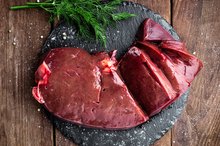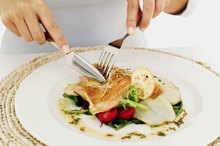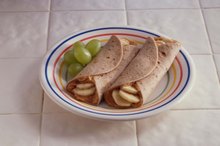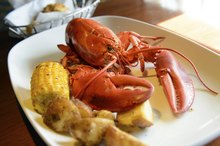Foods You Can Eat If You Have Gout
Gout, a form of arthritis that occurs when high uric acid blood levels cause crystals to form around a joint, is partially connected to diet. Uric acid is produced as your body breaks down purines, found in foods such as meat, seafood and alcohol. In the past, the treatment of gout included significant dietary restrictions. Newer medications for this disease, however, reduce the necessity of such a severe regimen. If you have been diagnosed with gout, you will still receive dietary recommendations, but they will offer options and a wide variety of food choices.
Beverage Selection
While you will need to limit or avoid alcohol, especially beer, when you are having an active attack, you do not need to give up alcohol completely. The Arthritis Foundation suggests that one drink for women and two drinks for men in a day is acceptable on a gout diet. Though you should avoid or limit drinks like soft drinks or juice drinks that are sweetened with high-fructose corn syrup, you may freely drink juices that contain 100 percent fruit juice. Coffee may also be an option for gout sufferers. In fact, the Arthritis Foundation reports that two separate studies show four or more cups of coffee a day actually reduce the risk of gout in men and that increasing coffee consumption decreases uric acid levels in men and women.
- While you will need to limit or avoid alcohol, especially beer, when you are having an active attack, you do not need to give up alcohol completely.
- In fact, the Arthritis Foundation reports that two separate studies show four or more cups of coffee a day actually reduce the risk of gout in men and that increasing coffee consumption decreases uric acid levels in men and women.
Protein Parameters
High Uric Acid Foods List
Learn More
Animal proteins are problematic as they are high in purines. If you avoid the very-high purine foods of organ meats, mackerel, anchovies, sardines, scallops, herring and game meats, however, you may be able to enjoy a moderate amount of meat, fish or poultry daily. Keep your intake to approximately 6 ounces a day.
Saturated Fat
Plant-based proteins, such as beans and legumes, are excellent options on a gout diet. If you choose these as your primary protein source, not only will you be avoiding the purines in animal proteins, but you will also be eating less saturated fat. Saturated fat decreases your body's ability to get rid of uric acid, so it may increase the risk of gout symptoms. For this reason, though dairy products such as milk, cheese and yogurt are allowable, opt for low-fat or fat-free choices. According to Gout.com, consumption of low-fat dairy products has also been associated with a decreased risk of gout.
- Plant-based proteins, such as beans and legumes, are excellent options on a gout diet.
Acceptable Carbohydrates
Which Proteins Are Good for Gout?
Learn More
Most carbohydrates are acceptable on a gout diet. You can eat fruits, vegetables and grains. You may need to limit high-purine vegetables, including spinach, cauliflower, asparagus and mushrooms. The Gout and Uric Acid Education Society, however, reports that these vegetables may not increase gout symptoms to the extent once thought. High-fructose fruits such as apples, peaches and pears may need to be kept at two servings a day. In addition, whole-grain products are better choices than refined carbohydrates like white bread and cookies. Whole-grain products tend to create a sense of fullness and may be helpful in losing weight. This is important because obesity has been linked to an increased risk of developing gout.
- Most carbohydrates are acceptable on a gout diet.
- High-fructose fruits such as apples, peaches and pears may need to be kept at two servings a day.
Add Cherries
An interesting suggestion for gout is to add tart cherries to your diet. Dr. Andrew Weil reports that laboratory findings at Michigan State University showed consumption of 20 tart cherries a day inhibited an enzyme that caused inflammation. Cherries have also been connected with a decrease in uric acid levels. Before you make any dietary changes, however, consult your physician.
- An interesting suggestion for gout is to add tart cherries to your diet.
- Dr. Andrew Weil reports that laboratory findings at Michigan State University showed consumption of 20 tart cherries a day inhibited an enzyme that caused inflammation.
Related Articles
References
- National Institute of Arthritis and Musculoskeletal and Skin Diseases: Gout
- Weil: Condition Care Guide, Gout
- Arthritis Foundation: Healthy Foods for Gout
- Gout and Uric Acid Education Society: Gout Diet
- U.S. Department of Health and Human Services and U.S. Department of Agriculture. 2015–2020 Dietary Guidelines for Americans. 8th Edition. Published December 2015.
- U.S. Department of Health and Human Services. Gripped by Gout. NIH News in Health. Published February 2014.
- National Institute of Arthritis and Musculoskeletal and Skin Diseases. Gout. Updated April 2016.
- Zhang Y, Chen C, Choi H, et al. Purine-rich foods intake and recurrent gout attacks. Ann Rheum Dis. 2012; 71(9):1448-53. doi:10.1136/annrheumdis-2011-201215
- Fischer E. Ueber die Harnsauer. 1 [On Uric Acid. 1]. Berichte der Deutschen Chemischen Gesellschaft. 1884: 17:328-338. doi:10.1002/cber.18980310304
- Ragab, G., Elshahaly, M., & Bardin, T. (2017). Gout: An old disease in new perspective – A review. Journal of Advanced Research, 8(5), 495–511. doi:10.1016/j.jare.2017.04.008
- Centers for Disease Control and Prevention. Gout. Updated January 28, 2019.
- Zgaga, L., Theodoratou, E., Kyle, J., Farrington, S. M., Agakov, F., Tenesa, A., … Campbell, H. (2012). The Association of Dietary Intake of Purine-Rich Vegetables, Sugar-Sweetened Beverages and Dairy with Plasma Urate, in a Cross-Sectional Study. PLoS ONE, 7(6), e38123. doi:10.1371/journal.pone.0038123
- Choi HK, Gao X, Curhan G. Vitamin C intake and the risk of gout in men: a prospective study. Arch Intern Med. 2009;169(5):502–507. doi:10.1001/archinternmed.2008.606
- Zhang Y, Neogi T, Chen C, Chaisson C, Hunter DJ, Choi HK. Cherry consumption and decreased risk of recurrent gout attacks. Arthritis Rheum. 2012;64(12):4004–4011. doi:10.1002/art.34677
- Arthritis Foundation. Gout Diet: Dos and Don’ts.
- Boban M, Modun D. Uric acid and antioxidant effects of wine. Croat Med J. 2010;51(1):16–22. doi:10.3325/cmj.2010.51.16
- Caliceti C, Calabria D, Roda A, Cicero AFG. Fructose Intake, Serum Uric Acid, and Cardiometabolic Disorders: A Critical Review. Nutrients. 2017;9(4):395. Published 2017 Apr 18. doi:10.3390/nu9040395
- U.S. Department of Health and Human Services and U.S. Department of Agriculture. 2015–2020 Dietary Guidelines for Americans. 8th Edition. Published December 2015.
- U.S. Department of Health and Human Services. Gripped by Gout. NIH News in Health. Published February 2014.
- Kakutani-Hatayama M, Kadoya M, Okazaki H, et al. Nonpharmacological Management of Gout and Hyperuricemia: Hints for Better Lifestyle. Am J Lifestyle Med. 2015;11(4):321–329. Published 2015 Sep 2. doi:10.1177/1559827615601973
Writer Bio
Ellen Topness has been a counselor in the mental health field for more than 25 years. She has a Master of Arts in counseling. Throughout her career, Topness has enjoyed writing articles, poems and vignettes for pleasure. She also released a new ebook, "A Natural Disaster: Learning to Survive Myself."









